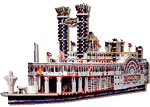Mississippi Steamboat

test
Five years later, the steamboat Washington embarks on its maiden voyage. The 148-foot, 400-ton Washington is fitted with sidewheels, a rear paddlewheel, two decks that rise high above the water and two tall chimneys. Its design inspires spectators to call her a "floating wedding cake". The contemporary and elegant Washington would set a new standard for thousands of US riverboats.
Progress not withstanding, the large river-going ships travel at a lumbering pace. The slow engine, powered by wood until the mid 1800s, and subsequently by coal, causes the paddlewheel to straggle in the waters.
Ultimately, old boilers give way to new high-pressure boilers, ...and a new set of problems. Constructed with poor quality materials, the boilers are prone to explosions.
Enter a breakthrough at the end of the 19th Century, when steel is used to fashion a more pressure-resistant boiler. The train, however, emerges as the transportation mode of choice throughout the continent, relegating such celebrated steamboats like the Natchez, the Robert E. Lee and the 37-meter (122 feet) long and 8-meter (26 feet) wide Chaperon to the annals of history.
